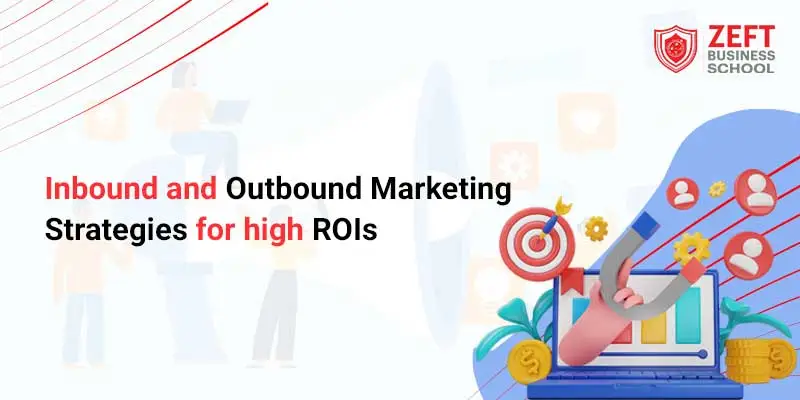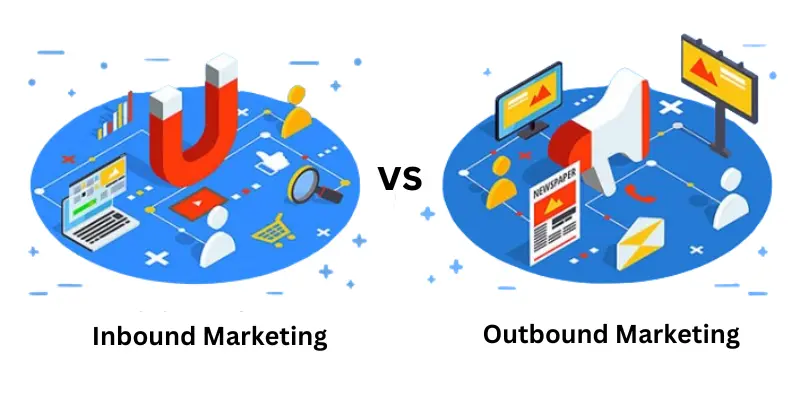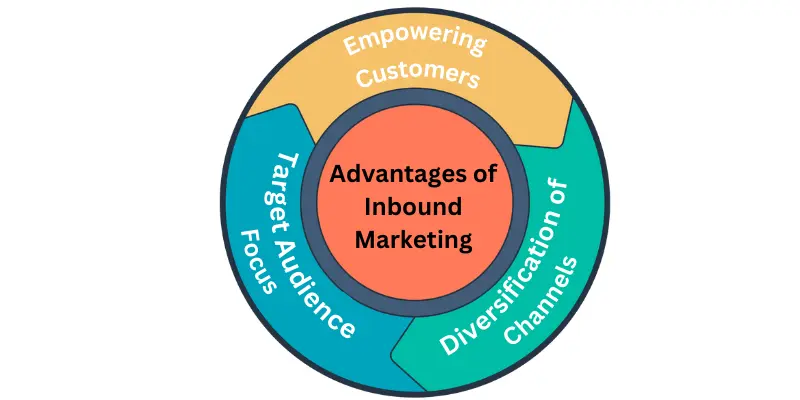In the dynamic realm of digital marketing, where consumer behaviour evolves rapidly, businesses seek innovative strategies to engage with their audience effectively. Among these strategies, inbound marketing emerges as a beacon of light, guiding brands towards authentic interactions and sustainable growth.
This blog takes you on a journey to delve deeper into the essence of inbound marketing and unravel its transformative potential.
What is Inbound Marketing?
Inbound marketing is a customer-centered approach focused on attracting, engaging, and delighting potential customers through valuable and relevant content. Unlike outbound marketing, which relies on intrusive tactics to push messages onto consumers, inbound marketing seeks to pull audiences in by offering solutions to their problems and addressing their needs organically.
As per the inbound marketing definition, inbound marketing revolves around crafting compelling content that deeply resonates with your target audience, thereby posing your brand as trusted and industry thought leader. Businesses can connect with their audience authentically by strategically utilising channels like search engines, social media, and content marketing, fostering long-term brand affinity and loyalty.
Inbound Marketing vs Outbound Marketing
To grasp the essence of inbound marketing, it’s essential to understand its distinction from outbound marketing. While inbound marketing is initiated for and by the consumer, outbound marketing involves proactive outreach and direct advertising. Inbound marketing focuses on earning customers’ attention through valuable content, while outbound marketing interrupts their experience with promotional messages.
Take Airbnb, for example. Instead of bombarding users with traditional advertising, Airbnb leverages the power of inbound marketing by showcasing inspiring travel stories, destination guides, and user-generated content on its platform. By partnering with an inbound marketing company and focusing on storytelling and community engagement, Airbnb creates an immersive experience that resonates with travellers worldwide, driving organic growth and brand advocacy.
By being aware of the difference between inbound and outbound marketing and strategically integrating both approaches, businesses like Coca-Cola maximised their impact, effectively leveraging the strengths of each to engage with their audience across multiple touchpoints and foster long-term loyalty.
Understanding the variance among inbound and outbound marketing and answering the question “what is inbound and outbound marketing?” is essential to grasping the essence of inbound marketing. Pursuing an MBA Digital Business equips professionals with the strategic insights and practical skills needed to navigate the complexities of both inbound and outbound marketing effectively. By delving into the nuances of consumer behaviour, digital analytics, and emerging technologies.
The critical difference lies in the approach: inbound marketing emphasises creating content that naturally attracts and engages customers, while outbound marketing relies on direct paid advertising and promotional tactics with proactive outreach to push messages onto consumers.
While both strategies have merits, inbound marketing offers a more sustainable and customer-centric approach to marketing in the digital age. It focuses on earning customers’ attention through valuable content. In contrast, outbound marketing interrupts their experience with promotional messages.
The Mechanics of Inbound Marketing
Inbound marketing operates on empathy and understanding the customer’s journey, beginning with identifying your target audience’s questions, pain points, and aspirations. Buffer, a social media management platform, exemplifies this approach by offering valuable resources and educational content, guiding businesses through the complexities of social media marketing with comprehensive guides, insightful webinars, and innovative inbound marketing tools.
How to Do Inbound Marketing
In the digital landscape, mastering the art of inbound marketing is essential for businesses aiming to attract, engage, and delight their target audience. Let’s delve into the critical components of executing a successful inbound marketing strategy:
Content Creation and SEO
What is critical to any inbound marketing strategy is crafting top-notch, relevant content tailored to your audience’s needs. Content forms the bedrock of inbound marketing endeavours, whether informative blog posts, captivating videos, or insightful whitepapers.
As an exemplary content creator and SEO player, Moz stands out as an inbound marketing company. Through its informative blog posts, educational webinars, and comprehensive SEO guides, Moz has cemented its authority in the digital marketing realm, offering valuable insights and tools for inbound marketing professionals. Moz effectively draws organic traffic and engages its audience by consistently delivering high-quality content optimized for relevant keywords and leveraging inbound marketing tools.
By strategically incorporating relevant keywords, optimising meta tags, and enhancing website performance using inbound marketing tools, businesses can improve their SERP (search engine results pages) ranking prospects and building connections with their target audience.
MBA Colleges in Chennai recognise the importance of content creation excellence in the digital age. They provide informative blog posts and articles on various topics related to business, management, and the ever-evolving digital landscape, preparing students to excel in leveraging inbound marketing strategies effectively in their careers.
Utilising Inbound Marketing Tools
In today’s digital age, leveraging the right inbound marketing tools and technology is paramount to executing an effective strategy. From marketing automation platforms to analytics tools, these resources enable businesses to streamline processes, track performance, and gain valuable insights into customer behaviour.
Marketo Engage, a comprehensive inbound marketing platform by Adobe, empowers businesses to orchestrate personalised experiences, optimise content, and measure the impact of their inbound marketing efforts across every channel. Marketo Engage enables brands to nurture leads, drive conversions, and maximise ROI by seamlessly integrating with inbound marketing strategies.
Alignment of Marketing and Sales Teams
Fostering alignment between the marketing and sales teams is essential to capitalise on inbound marketing’s potential fully. By collaborating closely and sharing insights, these departments can identify and prioritise leads, tailor messaging to specific audiences, and optimise the conversion process.
Pipedrive, a popular CRM software, is an excellent example of aligning marketing and sales teams in inbound marketing. Through its innovative inbound marketing tools and emphasis on inbound content marketing, Pipedrive centralises customer data, streamlines communication between departments, and automates lead management processes. This enables businesses to nurture leads seamlessly, drive conversions, and maximise the effectiveness of their inbound marketing initiatives through collaborative efforts between marketing and sales teams.
Maintenance of Channels and Platforms
Consistent maintenance of channels and platforms is crucial for sustaining the effectiveness of inbound and outbound marketing campaigns. Whether it’s updating content, optimising the user experience, or monitoring engagement metrics, ongoing management ensures that brands remain relevant and impactful in the eyes of their audience.
Buffer, a social media management platform, exemplifies the importance of platform maintenance in driving inbound engagement. By utilising inbound marketing tools and consistently sharing valuable content, engaging with followers, and monitoring performance metrics, Buffer maintains a strong presence on social media channels, attracting new followers and nurturing existing relationships.
Management of Inbound Marketing with the Right Tools
Effective inbound marketing management requires the right tools and technologies to streamline processes, track performance, and optimise campaigns for success. These resources, from marketing automation platforms to analytics tools, enable businesses to execute data-driven strategies and achieve their marketing objectives.
As a top inbound marketing company, Hootsuite provides businesses with robust inbound marketing tools to enhance their social media management efforts. From scheduling posts and monitoring conversations to analysing performance metrics and tracking ROI, Hootsuite offers effective solutions for businesses seeking to optimise their social media presence. By leveraging Hootsuite’s suite of tools, businesses can streamline their inbound marketing workflows, maximise engagement with their audience, and efficiently achieve their marketing objectives.
Integration with Outbound Marketing Efforts
While inbound marketing forms the foundation of modern marketing strategies, its impact can be amplified through strategic integration with outbound tactics. By combining inbound and outbound marketing efforts, businesses can maximise reach, engagement, and conversion opportunities across multiple channels.
Coca-Cola seamlessly integrates inbound and outbound marketing efforts to engage with its audience across multiple touchpoints. While traditional advertising campaigns raise awareness and drive brand recall, Coca-Cola’s focus on user-generated content, influencer partnerships, and interactive experiences fosters more profound connections with its consumers. By combining outbound messaging with inbound engagement tactics, Coca-Cola created a cohesive brand experience that resonates with its audience and drives long-term loyalty.
Understanding how inbound and outbound marketing work together is crucial for succeeding in the ever-changing business world. But more than just learning about it experience in putting it in practice is necessary. That’s why getting an MBA Digital Marketing in Chennai is a smart move for young entrepreneurs who want to stand out in the competitive market.
Benefits of Inbound Marketing
The benefits of inbound marketing extend beyond mere lead generation; it fosters genuine connections with customers, nurtures brand loyalty, and drives sustainable growth. By empowering customers with valuable information and resources, establishing trust and respect as the foundation of enduring partnerships.
Zendesk, a customer service software company, exemplifies the transformative power of inbound marketing. Through its extensive library of resources, including webinars, whitepapers, and case studies, Zendesk educates users on best practices and current customer support trends. This commitment to knowledge sharing attracts potential customers and strengthens the bond with existing ones, building long-term relationships built on mutual respect and trust.
Integrating Outbound and Inbound Marketing
While inbound marketing forms the cornerstone of modern marketing strategies, its impact can be amplified through strategic integration with outbound tactics. Using outbound channels like email marketing and paid advertising to promote inbound content allows businesses to reach a wider audience and increase engagement.
Nike, the global sportswear giant, exemplifies this synergy between inbound and outbound marketing. Nike created widespread awareness and brand recognition through its captivating ad campaigns and sponsorship deals. However, it’s its commitment to storytelling and community engagement, manifested through initiatives like the Nike Run Club app and interactive training content, that truly captivates audiences and fosters lasting connections.
A wide range of MBA programs catering to diverse interests and career goals are available. MBA courses offered by ZEFT Business School stands out for its effective emphasis on inbound marketing, empowering students to confidently navigate this rich educational landscape.
Advantages of Inbound Marketing
Empowering Customers
At the heart of inbound marketing lies a fundamental shift in power dynamics. Unlike traditional outbound marketing tactics, which rely on interruptive advertising to capture attention, inbound marketing puts the customer in the driver’s seat.
Brands help consumers make educated decisions at every stage of the customer journey by offering meaningful and clear content that caters to the needs and interests of their target audience. Through insightful blog posts, educational resources, and engaging social media content, businesses position themselves as trusted advisors, nurturing relationships beyond mere transactions. This customer-centric approach strengthens credibility and fosters enduring connections, aligning with the essence of inbound content marketing.
Target Audience Focus
Inbound and outbound marketing strategies differ fundamentally in their approach to audience engagement. Inbound marketing focuses on understanding and connecting with the target audience on a deeper level through data analytics and consumer insights. By leveraging these tools, businesses gain invaluable insights into audience preferences, pain points, and behaviours, which are then used to tailor messaging and content.
In contrast, outbound marketing typically employs a more generalised, one-size-fits-all approach. While both strategies aim to engage with audiences, inbound marketing emphasizes personalised interactions and content creation to resonate with specific audience segments. This distinction highlights the importance of adopting an inbound and outbound marketing approach that effectively engages audiences meaningfully.
Diversification of Channels
Consumers interact with brands across many channels and platforms in today’s hyper-connected world. Numerous channels for interaction are available in the digital world, ranging from email newsletters and mobile apps to social media and search engines.
Inbound marketing, championed by leading inbound marketing companies, embraces this diversity of channels, recognizing that different audiences may prefer different mediums for consuming content and engaging with brands. By leveraging specialised inbound marketing tools and embracing various types of inbound marketing strategies, businesses can reach audiences where they are most active and receptive.
With the help of inbound marketing, firms can reach a broad audience and draw in customers at several touchpoints by optimizing website content for search engines and building a strong presence in social media. This multi-channel approach enhances brand visibility and fosters greater customer engagement and interaction.
Inbound marketing empowers potential students and educational institutions alike. Both parties can foster meaningful connections and achieve their goals by strategically creating and consuming valuable content. For aspiring entrepreneurs, inbound marketing can be invaluable for learning about the exciting world of business, exploring MBA Courses in Chennai, and ultimately making informed decisions about their future careers.




